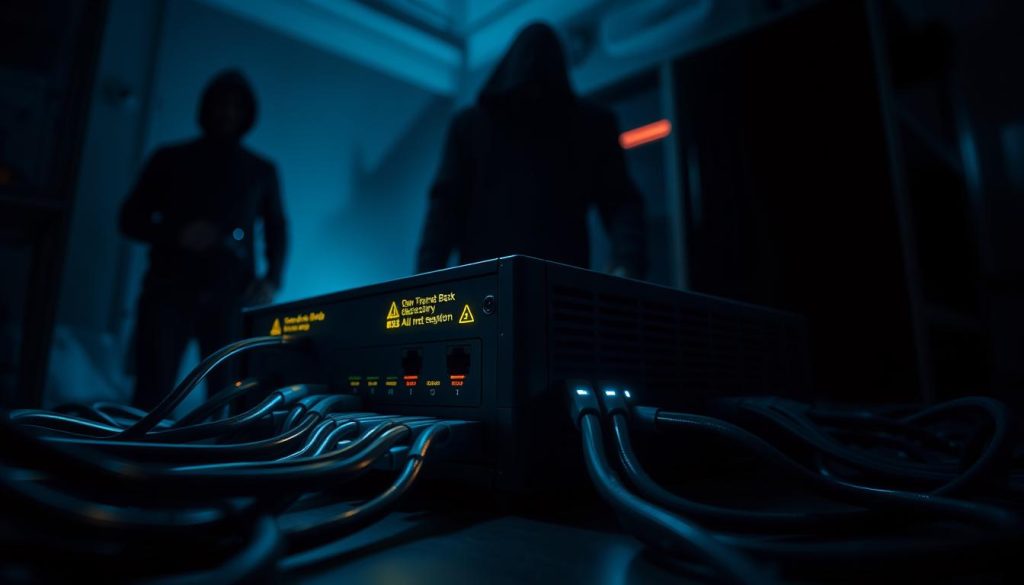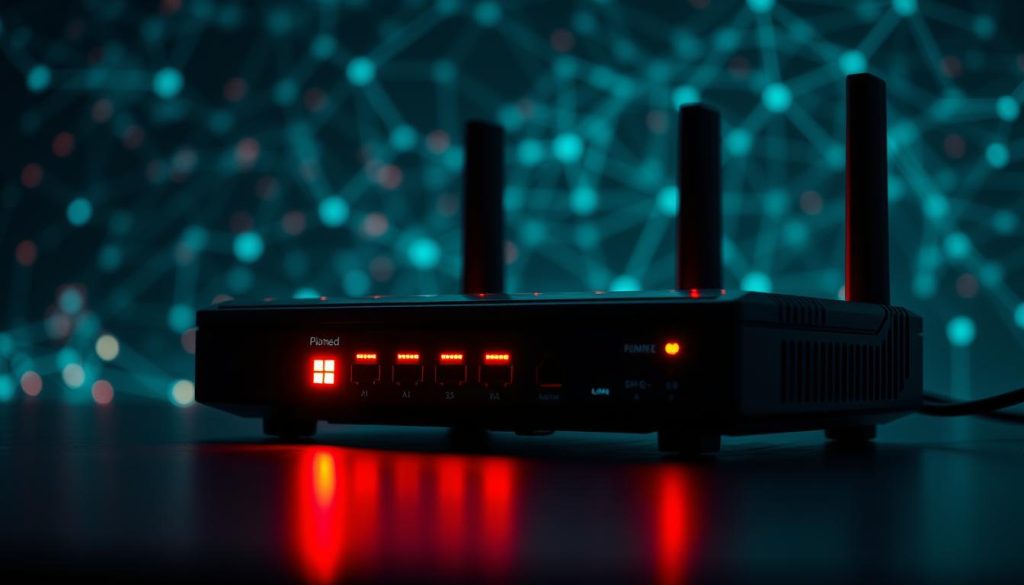Recent cybersecurity news has highlighted alarming threats to your household’s safety. The FBI has issued warnings about VPNFilter malware, which targets routers and leaves your network vulnerable. This malware can compromise your devices, giving hackers access to sensitive information.
In 2025, ransomware attacks against households surged by 37%, making it clear that outdated routers and weak passwords are a major risk. Many families have experienced smart device hijackings, showcasing the need for immediate action to secure your network.
Protecting your devices and network is more critical than ever. By updating your router and using strong passwords, you can defend against these evolving threats. Stay informed and take steps to ensure your family’s security.
Why Your Home Internet Might Be at Risk
Your network might be more vulnerable than you think. A recent study of 127 households found that the average router has over 100 vulnerabilities. These weaknesses can leave your data exposed to hackers.
One common issue is the use of default SSIDs. These make it easier for attackers to identify your provider and exploit known weaknesses. Changing your SSID is a simple step that can significantly reduce risks.

IoT devices like baby monitors and smart speakers are also at risk. Many of these devices lack proper security features, making them easy targets for hackers. Ensuring they are updated and protected is crucial.
Remote management features on routers can create backdoors for attackers. Disabling these features unless absolutely necessary can help secure your connection.
Another alarming statistic: 68% of families reuse passwords across multiple devices. This practice makes it easier for hackers to gain access to your entire network. Using unique, strong passwords for each device is essential.
10 Signs Your Home Internet Has Been Hacked
Recognizing the signs of a compromised network can save you from major headaches. Cybercriminals often leave subtle clues that something is wrong. By staying alert, you can take action before the situation worsens.

1. Router Login Failures
If you’re unable to log into your router, it could mean someone else has taken control. Change your credentials immediately to regain access.
2. Slow Internet Speeds
A sudden drop in speed might indicate unauthorized devices using your connection. Check your network for unfamiliar devices.
3. Browser Redirects
Being sent to strange websites without clicking anything is a red flag. This could mean malware is redirecting your traffic.
4. Suspicious Network Activity
Unusual data spikes or activity at odd hours could signal a breach. Monitor your network for irregularities.
5. Unfamiliar Software Downloads
Finding unknown programs on your devices is a clear warning. These could be malicious tools installed by hackers.
6. Session Hijacking
If your accounts log out unexpectedly, someone might be hijacking your sessions. Enable two-factor authentication for added security.
7. Ransomware Messages
Receiving demands for payment to unlock your files is a serious sign. Disconnect your device and seek professional help immediately.
8. Fake Antivirus Notifications
Pop-ups claiming your device is infected are often scams. Avoid clicking on them and run a trusted antivirus scan.
9. Increase in Pop-Up Ads
A sudden surge in ads can indicate adware. Clear your browser cache and scan for malware.
10. Alerts from Your Internet Provider
Some providers, like Comcast/Xfinity, use anomaly detection systems to warn you of suspicious activity. Always verify these alerts to avoid phishing scams.
If you suspect your network is compromised, contact your provider directly. Here are support numbers for major ISPs:
– Comcast/Xfinity: 1-800-XFINITY
– AT&T: 1-800-288-2020
– Spectrum: 1-833-267-6094
Common Vulnerabilities in Home Networks
Your router might be the weakest link in your digital security. Many households overlook the risks lurking in their networks, leaving them exposed to cyberattacks. Understanding these vulnerabilities is the first step toward protecting your devices and data.
Network Weaknesses
One of the most common issues is outdated systems. A staggering 92% of hacked routers had unpatched vulnerabilities, known as CVEs. For example, CVE-2025-1234 allowed attackers to bypass security protocols entirely. Regularly checking for and addressing these flaws is essential.
Remote Management Risks
Remote management features can be a double-edged sword. While convenient, they often create backdoors for hackers. Disabling these features unless absolutely necessary can significantly reduce your risk of a breach.
Outdated Firmware
Firmware is the software that runs your router. Outdated firmware is a goldmine for hackers. Here’s how to update it:
- Log into your router’s admin panel using your IP address.
- Navigate to the firmware or updates section.
- Download the latest version from the manufacturer’s official site.
- Follow the on-screen instructions to complete the update.
Be cautious of third-party sites claiming to offer firmware updates. These are often phishing attempts designed to steal your information. Always download updates directly from the manufacturer’s website.
By addressing these vulnerabilities, you can strengthen your network’s defenses and protect your devices from potential threats.
How to Fix a Hacked Router
Discovering your router has been compromised can be overwhelming, but taking immediate action is crucial. By following these steps, you can regain control and secure your network from further threats.
Step 1: Disconnect from the Internet
The first step is to unplug your router from the internet. This prevents hackers from accessing your network while you work on fixing the issue. Disconnecting also stops any ongoing attacks on your devices.
Step 2: Reset Your Router
Locate the reset button on your router—usually a small pinhole. Hold it down for 10-15 seconds to restore factory settings. This removes any malicious changes made by hackers.
Step 3: Change Your Passwords
After resetting, create a new, strong password for your router. Use a mix of letters, numbers, and symbols. Also, update passwords for all connected devices to protect your data.
Step 4: Update Firmware
Log into your router’s admin panel and check for firmware updates. Outdated firmware is a common vulnerability. Download updates only from your provider’s official website to avoid phishing scams.
Step 5: Contact Authorities (If Necessary)
If you’ve experienced significant damage, report the incident to the FBI’s IC3 portal. Collect evidence like screenshots and logs to support your case. For identity theft concerns, visit FTC IdentityTheft.gov.
One success story involves a family who recovered stolen cryptocurrency by reporting the breach promptly. Taking these steps can help you protect your network and prevent future attacks.
Preventing Future Home Internet Hacks
Staying ahead of cyber threats requires proactive measures. By implementing a few key strategies, you can significantly reduce the risk of hackers targeting your network. Let’s explore the best practices to keep your connection secure.
Set Up Automatic Firmware Updates
Keeping your router’s firmware up to date is crucial. Outdated firmware often contains vulnerabilities that hackers exploit. Enable automatic updates to ensure you’re always protected against the latest threats.
Disable Remote Access
Remote management features can be convenient but also risky. Unless absolutely necessary, disable remote access to your router. This eliminates a potential backdoor for attackers.
Use Complex Passwords
Weak passwords are a hacker’s best friend. Create strong, unique passwords for your router and all connected devices. Use a mix of letters, numbers, and symbols for maximum security.
Create a Unique SSID
Default SSIDs make it easier for hackers to identify your provider and exploit known weaknesses. Change your SSID to something unique and avoid using personal information in the name.
Turn Off WPS
Wi-Fi Protected Setup (WPS) is a convenient feature but is often insecure. Disable WPS to prevent hackers from bypassing your network’s password.
Install a VPN
A VPN adds an extra layer of protection by encrypting your internet traffic. Router-level VPN configuration ensures all devices on your network are secure. Compare protocols like AES-256 and WireGuard for optimal performance.
Be cautious of free VPNs, as they may sell your data. Invest in a reputable service like Norton or ExpressVPN for reliable security. By following these steps, you can safeguard your network and enjoy peace of mind.
Securing Your Smart Home Devices
Smart home devices bring convenience but also introduce new risks. In 2025, over 43,000 Ring camera breaches were reported, highlighting the need for better security. Protecting your devices is essential to keep hackers at bay.
Some IoT gadgets are more vulnerable than others. Smart plugs, baby monitors, and security cameras are common targets. These devices often lack robust security features, making them easy prey for hackers.
One of the simplest ways to secure your devices is by changing default passwords. Many users overlook this step, leaving their networks exposed. Create strong, unique passwords for each device to minimize risks.
Another effective strategy is VLAN segregation. By separating your IoT devices from your main network, you can limit access for hackers. This setup ensures that even if one device is compromised, the rest of your network remains safe.
Stay proactive in securing your smart home devices. Regularly update firmware, disable unused features, and monitor for unusual activity. These steps can help you enjoy the benefits of smart technology without compromising your security.
How to Encrypt Your Home Wi-Fi Network
Encrypting your Wi-Fi is a critical step to safeguard your data. Without proper encryption, your network becomes an easy target for hackers. Upgrading to the latest protocols ensures your connection remains secure.
WPA3 is the newest and most advanced encryption standard. It offers stronger security compared to WPA2, especially with its Simultaneous Authentication of Equals (SAE) handshake protocol. SAE prevents brute-force attacks, making it harder for intruders to crack your password.
To enable encryption, log into your router’s admin panel. For most routers, you’ll find the settings under the “Wireless” or “Security” tab. Look for options like WPA3 or WPA2 and select the strongest available protocol.
If you have older devices that don’t support WPA3, you can temporarily downgrade to WPA2. However, ensure you upgrade back to WPA3 once all devices are compatible. This ensures your network remains protected without leaving older devices vulnerable.
By taking these steps, you can significantly enhance your Wi-Fi’s security and keep your data safe from unauthorized access.
Setting Up a Guest Network for Added Protection
Creating a guest network is a smart way to enhance your digital security. It separates your primary connection from visitors, reducing the risk of unauthorized access. This setup is especially useful for protecting your personal data and devices.
One effective feature is bandwidth throttling for guests. This limits their access to your main network’s resources, ensuring your devices run smoothly. Tools like Xfinity xFi Advanced Security make it easy to manage these settings.
For added safety, rotate your guest network password daily. This prevents long-term access by unauthorized users. A strong, unique password is essential for keeping your connection secure.
Consider migrating IoT devices to the guest network. This isolates them from your main system, minimizing potential risks. By taking these steps, you can enjoy a safer and more efficient digital experience.
Why Router Firewalls Are Essential
Your router’s firewall is your first line of defense against cyber threats. It acts as a barrier, blocking unauthorized access and keeping your devices safe. Without it, your network is vulnerable to attacks.
Firewalls use techniques like Stateful Packet Inspection (SPI) to monitor incoming and outgoing traffic. SPI is more effective than Network Address Translation (NAT) because it analyzes data packets in real-time. This ensures only legitimate traffic gets through.
Some of the best router firewalls include Firewalla Gold and Netgate 6100. These devices offer advanced features like intrusion detection and custom rule creation. For example, you can set rules to prioritize gaming traffic for a smoother experience.
Creating custom rules is simple. Log into your router’s admin panel, navigate to the firewall settings, and add rules based on your needs. This level of control ensures your network stays secure while meeting your specific requirements.
By investing in a robust firewall, you can protect your devices and enjoy peace of mind. It’s a small step that makes a big difference in your digital security.
Take Control of Your Home Internet Security Today
Securing your network doesn’t have to be complicated, but it does require action. On average, a breach can happen in just 7 minutes. Don’t wait until it’s too late—start protecting your devices now.
Download our free security health check checklist to ensure your network is safe. It’s a simple guide to help you identify vulnerabilities and take immediate steps to fix them.
For added protection, try Norton 360 Deluxe with a 30-day free trial. This tool offers comprehensive security features to keep your devices and data safe from threats.
Identity theft is a growing concern, with millions affected each year. Stay vigilant and take proactive measures to safeguard your information. Your router and network are the first lines of defense—make sure they’re secure.
Take control today. Your peace of mind is worth it.

